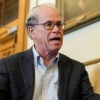It seemed so simple: To reduce energy use, Americans must abandon the old-fashioned incandescent light bulb in favor of new energy-efficient lighting. Congress even passed legislation in 2007 mandating a phase-out of the familiar “Edison” bulb in the name of saving energy.
Now comes a study concluding that energy-efficient lighting will likely increase energy use. The study, sponsored by Sandia National Laboratories in New Mexico and funded by the U.S. Department of Energy, is based on the observation that the percentage of gross national product spent on artificial lighting has remained remarkably constant for the past three hundred years. Instead of using advances in technology to reduce expenditures on energy, individuals have consistently opted to take advantage the lower costs made possible by those advances to increase the light around them.
The same result is likely with new technologies, the new study’s authors find, focusing particularly on solid-state lighting technologies such as light-emitting diodes (LEDs). The increase in energy use may be substantial. The report estimates that the total consumption of light could increase by a factor of 10 over the next two decades. And the amount of energy used to produce that light could double.
That’s bad news if your only goal is to reduce energy consumption. But if you are actually concerned with improving human welfare, it’s quite good news. Benefits could range from increased workplace efficiency to reduced crime to fewer cases of depression. “[R]ather than functioning as an instrument of decreased energy use,” said lead author Jeff Tsao of Sandia, “LEDs may be instead the next step in increasing human productivity and quality of life.”
If that’s correct, there’s still no reason to make the new lighting technology mandatory. But for the reduce-energy-consumption-at-all-costs crowd, the prospects may create a dilemma. For them, as The Economist wrote, “the answer may not be to ban old-fashioned incandescent bulbs … but to make them mandatory.”
































15 Replies to “And Then There Was Light: Will Energy-Efficient Light Bulbs Increase Energy Use?”